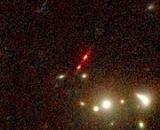
Lynx Arc
Encyclopedia
The Lynx Arc was discovered in 2003 and is considered to be the hottest known star-birthing region in the Universe
as of October 2003. It is located at .
It is located in the constellation Lynx
, 12 billion light years away (z=3.357) from earth, 8 million times farther away and one million times brighter than the Orion Nebula
. It contains about 1 million blue stars, while the Orion Nebula only contains 4.
The Lynx Arc was found in a systematic search around galaxy cluster
RX J0848+4456 (z=0.570), with the help of a gravitational lens
, a 4.5 billion light years distant galaxy cluster (CL J0848.8+4455 lying at z=0.543). Amongst others the Keck Observatory, the Hubble Space Telescope
and ROSAT
participated in the search.
Located behind a cluster of galaxies in northern Constellation Lynx around 12 billion light-years (ly) away, the Lynx Arc is a distant supercluster of extremely hot, young stars. Roughly one million times brighter than the well-known Orion Nebula, the Lynx Arc contains a million blue stars that are twice as hot as similar stars in the Milky Way galaxy. Only visible through gravitational lensing by a closer cluster of galaxies, the Arc is a feature of the early days of the universe, when "furious firestorms of star birth" were more common. It may be going through a short-lived luminous phase that may have lasted for as little as a few million years (Fosbury et al, 2003, in pdf).
The surface temperature of the stars in the Lynx Arc is estimated to be around 80000°K, about twice as hot as stars in our neighborhood. Only the stars formed directly after the Big Bang
(Population III stars) are considered to be hotter (around 120000°K). The universe was only 2 billion years old at the time at which we are observing the Lynx Arc. The first stars were born 1.8 billion years before the Lynx Arc.
Universe
The Universe is commonly defined as the totality of everything that exists, including all matter and energy, the planets, stars, galaxies, and the contents of intergalactic space. Definitions and usage vary and similar terms include the cosmos, the world and nature...
as of October 2003. It is located at .
It is located in the constellation Lynx
Lynx (constellation)
Lynx is a constellation in the northern sky, introduced in the 17th century by Johannes Hevelius. It is named after the lynx, a genus of cat. It is a very faint constellation; its brightest stars form a zigzag line.-History:...
, 12 billion light years away (z=3.357) from earth, 8 million times farther away and one million times brighter than the Orion Nebula
Orion Nebula
The Orion Nebula is a diffuse nebula situated south of Orion's Belt. It is one of the brightest nebulae, and is visible to the naked eye in the night sky. M42 is located at a distance of and is the closest region of massive star formation to Earth. The M42 nebula is estimated to be 24 light...
. It contains about 1 million blue stars, while the Orion Nebula only contains 4.
The Lynx Arc was found in a systematic search around galaxy cluster
Galaxy cluster
A galaxy cluster is a compact cluster of galaxies. Basic difference between a galaxy group and a galaxy cluster is that there are many more galaxies in a cluster than in a group. Also, galaxies in a cluster are more compact and have higher velocity dispersion. One of the key features of cluster is...
RX J0848+4456 (z=0.570), with the help of a gravitational lens
Gravitational lens
A gravitational lens refers to a distribution of matter between a distant source and an observer, that is capable of bending the light from the source, as it travels towards the observer...
, a 4.5 billion light years distant galaxy cluster (CL J0848.8+4455 lying at z=0.543). Amongst others the Keck Observatory, the Hubble Space Telescope
Hubble Space Telescope
The Hubble Space Telescope is a space telescope that was carried into orbit by a Space Shuttle in 1990 and remains in operation. A 2.4 meter aperture telescope in low Earth orbit, Hubble's four main instruments observe in the near ultraviolet, visible, and near infrared...
and ROSAT
ROSAT
ROSAT was a German Aerospace Center-led satellite X-ray telescope, with instruments built by Germany, the UK and the US...
participated in the search.
Located behind a cluster of galaxies in northern Constellation Lynx around 12 billion light-years (ly) away, the Lynx Arc is a distant supercluster of extremely hot, young stars. Roughly one million times brighter than the well-known Orion Nebula, the Lynx Arc contains a million blue stars that are twice as hot as similar stars in the Milky Way galaxy. Only visible through gravitational lensing by a closer cluster of galaxies, the Arc is a feature of the early days of the universe, when "furious firestorms of star birth" were more common. It may be going through a short-lived luminous phase that may have lasted for as little as a few million years (Fosbury et al, 2003, in pdf).
The surface temperature of the stars in the Lynx Arc is estimated to be around 80000°K, about twice as hot as stars in our neighborhood. Only the stars formed directly after the Big Bang
Big Bang
The Big Bang theory is the prevailing cosmological model that explains the early development of the Universe. According to the Big Bang theory, the Universe was once in an extremely hot and dense state which expanded rapidly. This rapid expansion caused the young Universe to cool and resulted in...
(Population III stars) are considered to be hotter (around 120000°K). The universe was only 2 billion years old at the time at which we are observing the Lynx Arc. The first stars were born 1.8 billion years before the Lynx Arc.

